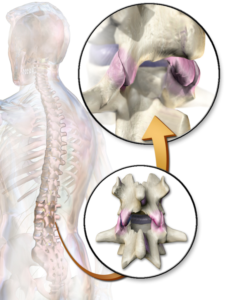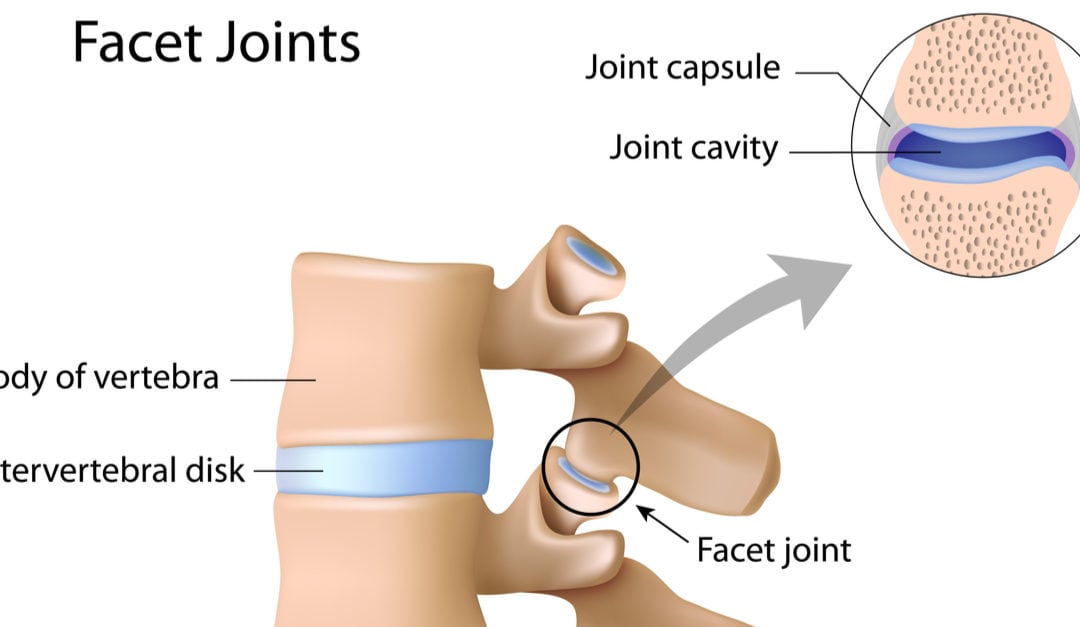The spine is one of the most important structures of the body as it has the crucial jobs of providing structure and support and protecting the spinal cord. It also enables movement of the neck, back, core and lower body. The joints, in addition to intervertebral discs, responsible for spine movements are the facet joints. Like all joints of the body, the facet joints are susceptible to arthritis. Facet joint arthritis is a painful condition that can alter the way patients live their lives.

Illustration 1- The facet joints
Symptoms of Facet Joint Arthritis
The main symptom of facet joint arthritis is pain in the spine or extremities when bending backward or sideways. Typically, pain increases with movement and activity. Symptoms like tingling and numbness are not seen unless a spinal cord or nerve compression condition like spinal stenosis or a herniated disc occurs in conjunction with facet joint arthritis.
Diagnosis of Facet Joint Arthritis
A Neurosurgeon diagnoses facet joint arthritis using the following:
- A medical history. Symptoms, medical conditions, activities, and prior injuries provide clues that facet joint arthritis may be present.
- A physical examination. A series of examinations help find the exact location and cause of pain.
- Medical imaging studies. X-rays, MRIs, and CT scans show arthritic damage to the facet joints and surrounding bone and soft tissue.
Once an accurate diagnosis is made, a treatment plan can be prescribed.
Treatment of Facet Joint Arthritis
Non-surgical treatment options typically resolve pain associated with facet joint arthritis. The most commonly used non-surgical treatment options include the following:
- Rest and ice. Slowing down or stopping movements and activities that cause pain and applying ice to painful areas helps reduce inflammation and pain.
- Physical therapy. Strengthening and stretching the muscle and ligaments of the spine helps correct muscle imbalances and enables patients to perform movements easily and without pain.
- Nonsteroidal anti-inflammatory drugs (NSAIDs). Over-the-counter and prescription medications that can be taken orally to resolve pain and decrease inflammation.
- Corticosteroid injections. Injecting an arthritic facet joint with powerful anti-inflammatory medications known as corticosteroids provides fast acting pain relief.
When these treatment options do not improve pain, surgical treatment may be necessary.
A facet rhizotomy is a surgical procedure in which tiny nerves that surround the facet joints are coagulated so they stop sending pain signals to the brain.
Seeking Treatment for Facet Joint Arthritis
If you are experiencing pain that gets worse when you move your spine, please contact our NYC office to make an appointment. Regardless of the severity of your condition, we will have a treatment option that is right for you. Dr. Patrick Senatus is a Board Certified Neurosurgeon in New York City with extensive experience in Minimally Invasive and Restorative Spine Surgery. Dr. Senatus employs a personalized patient-centered approach that prioritizes optimum functional outcome and well-being. Each consultation begins with a comprehensive evaluation by Dr. Senatus designed to create an individualized evidence based treatment plan which includes the patient, family, and collaborating providers.
Following a conservative treatment philosophy, Dr. Senatus offers his patients solutions using the most advanced minimally invasive spine surgery. His approach is to perform the most effective and least invasive intervention available, specifically tailored to each patient, guided by the principal that surgical options be considered only after all reasonable non-operative therapies have been exhausted. Returning his patients to a functional pain free lifestyle is the ultimate objective. Contact us today to schedule an appointment!


Recent Comments